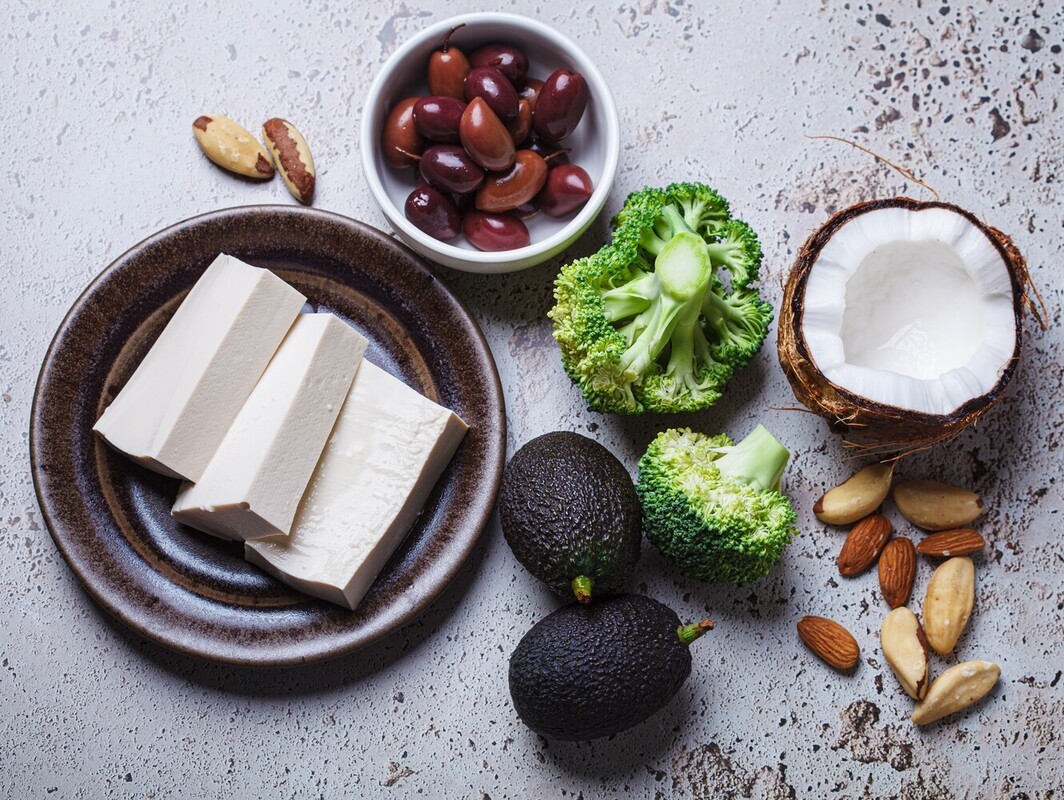A heart healthy diet plan is an eating plan designed to prioritize foods that promote heart health, like fresh fruits and vegetables, whole grains, lean proteins, and omega-3-rich fish such as salmon and tuna.
At Berry Street, we make it easy to connect with a Registered Dietitian who can create a plan uniquely tailored to your lifestyle.
In this article, we’ll explore actionable steps to prevent heart disease, share a sample menu, and provide recipes you can incorporate into your daily routine.
Let’s jump in!
Heart-Healthy Diet: Steps To Prevent Heart Disease
Adopting a heart healthy diet plan can significantly reduce your risk of heart disease.
Below, we break down eight practical steps to guide you toward better cardiovascular well being.
1. Control Portion Sizes
Portion size and control is key to maintaining a healthy weight and avoiding overeating. We suggest using smaller plates, bowls, and utensils to help reduce your food intake without feeling deprived.
The National Institutes of Health report that managing portion sizes can prevent excess calorie consumption, a major contributor to heart problems.
In this context, you should aim to fill your plate with:
50% fruit and vegetables
25% lean protein
25% whole grains
Those following a keto diet plan will also find portion control essential to meet their dietary goals.
2. Eat More Vegetables And Fruits
Incorporating a rainbow of fruits and vegetables into your meals containing nutrients and antioxidants can reduce your risk of chronic conditions such as heart disease.
We suggest snacking on crunchy carrot sticks or refreshing apple slices, or adding leafy greens like spinach or kale to your meals.
Through our practical knowledge, we’ve seen that this step aligns perfectly with a Mediterranean food diet plan, which focuses on plant-based ingredients, as well.
3. Choose Whole Grains
Whole grains like quinoa, brown rice, and whole-wheat bread are excellent sources of fiber, which can lower cholesterol and improve blood pressure.
Our findings show that this approach is also beneficial when crafting diet plans for lowering cholesterol.
4. Limit Unhealthy Fats
The Cleveland Clinic reported that saturated and trans fats can raise your cholesterol levels, increasing your risk of heart disease.
That’s why we recommend opting for healthy monounsaturated fats instead which can be found in avocados, nuts, and olive oil.
This means avoiding fried foods and reading food labels carefully to steer clear of hydrogenated oils.
5. Choose Low-Fat Protein Sources
Lean meats, poultry, fish, and plant-based proteins like lentils and beans are excellent low-fat options. Oily fish such as salmon and mackerel are rich in omega-3 fatty acids, which are known to support heart health.
You can even incorporate a handful of chia seeds into meals and snacks for an added protein boost.
When we tried out these various protein sources, we discovered that they reduce bad cholesterol levels while improving good cholesterol simultaneously.
These options can also fit seamlessly into a simple meal plan for elderly diabetics if you have loved ones wanting to consume more low-fat proteins in their regular diet.

6. Limit And Reduce Sodium And Salt
According to the Mayo Clinic, high sodium intake can lead to hypertension or high blood pressure, which is a major risk factor for heart disease.
As such, we recommend using low-sodium herbs and spices to flavor your meals instead, such as garlic, turmeric and paprika.
7. Plan Ahead And Create Daily Menus
Planning your meals in advance can help you make healthier choices and avoid impulse eating.
Start by preparing a weekly menu, including breakfast, lunch, dinner, and snacks to ensure a balanced diet and reduce the temptation to grab fast food.
We've found from using this service that meal planning curated by a virtual Registered Dietitian is a powerful tool helping you stay on track with heart-healthy eating.
8. Have A Treat Once In A While
Treats in moderation can be part of a heart healthy diet plan. You can enjoy a small piece of dark chocolate or a few almonds dipped in honey as a guilt-free indulgence.
Remember, balance is key, and occasional treats can help you stick to your long-term goals.
Menu Sample For Heart-Healthy Eating
Looking for inspiration? Here’s a sample menu filled with heart-healthy meals from us at Berry Street to try!

Breakfast: Avocado-Egg Toast (271 Calories)
For a heart-healthy start to the day which also fits into an easy low carb diet plan, this Avocado-Egg Toast is nutrient-packed to the max.
Ingredients:
¼ avocado
¼ tsp ground pepper
⅛ tsp garlic powder
1 slice toasted whole-wheat bread
1 large fried egg
1 tsp Sriracha (optional)
1 tbsp sliced scallion (optional)
Begin by toasting the bread until it’s golden brown, then set it aside on a plate. Next, mash the avocado with pepper and garlic powder in a bowl.
Heat the oil or cooking spray in a skillet, crack the egg, and fry until the whites set and the edges are crisp. Spread the avocado mash evenly on the toast, top with the fried egg, and garnish with scallions or Sriracha for added flavor.
This recipe provides heart-friendly fats, fiber, and protein to support cardiovascular health and maintain energy throughout your morning.
At Berry Street, a Registered Dietitian can incorporate this breakfast into a tailored meal plan to fulfill daily calorie needs for sustained aging and nutrition.
A.M. Snack: Blueberries (84 Calories)
Top up your energy levels with a cup of fresh blueberries during the mid-morning.
You can pour them into a bowl or pop them into your mouth one at a time. Either way, it’s an excellent snack when you’re constantly on the go.
Blueberries are rich in antioxidants that combat oxidative stress, a common contributor to heart disease. It’s an excellent way to jumpstart a heart-healthy regimen.
Discover heart-healthy meal plans tailored just for you—connect with a Berry Street dietitian covered by insurance today and transform your meals into wellness!

Lunch: Loaded Black Bean Nacho Soup (350 Calories)
Savor this hearty and flavorful Loaded Black Bean Nacho Soup, containing fresh toppings and crunchy tortilla chips that are perfect for a satisfying midday meal.
Ingredients:
1 carton (18 oz) low-sodium black bean soup
¼ tsp smoked paprika
½ tsp lime juice
½ cup halved grape tomatoes
½ cup shredded cabbage or slaw mix
2 tbsp crumbled cotija cheese
½ medium diced avocado
2 oz baked tortilla chips
Heat the black bean soup in a skillet on medium heat, then add the paprika and lime juice along with your favorite toppings, like. Remove it from heat and serve with the salsa, guacamole, sour cream and baked tortilla chips for an added Mexican flair to your lunchtime routine.
This soup is rich in fiber and antioxidants, supporting heart health, digestion, and blood sugar management.
At Berry Street, a cardiovascular dietitian and dietitian specializing in diabetes management can incorporate this meal into a heart-healthy or diabetic-friendly meal plan specifically tailored to your needs.
P.M. Snack: Orange (62 Calories)
For extra zest during the day, grab a medium-sized orange from the refrigerator or the kitchen island.
Oranges provide a refreshing, low-calorie snack packed with vitamin C and antioxidants. Moreover, our research indicates that it supports immune health and promotes heart health through the reduction of low-density lipoprotein (LDL) cholesterol.
Dinner: Seared Salmon With Green Peppercorn Sauce (457 Calories)
Enjoy this elegant, protein-rich Seared Salmon With Green Peppercorn Sauce topped with a tangy for an optimal heart-healthy dinner option.
Ingredients:
1¼ lb skinned and quartered wild salmon filet
¼ tsp divided salt
2 tsp canola oil
¼ cup lemon juice
4 tsp diced unsalted butter
1 tsp rinsed and crushed green peppercorns in vinegar

Start by searing the salmon in oil in a skillet on the stovetop. When the exterior is brown or charred on the outside, giving the skin a flaky complexion, remove the salmon from heat. Place it on a plate and let it rest for up to five minutes.
Next, add the lemon juice, butter, peppercorns, and remaining salt in the same skillet, stirring it together for a minute or so. Finally, drizzle the peppercorn sauce over the salmon and serve it with a side of steamed vegetables of your choosing.
Conclusion
In this article, we revealed that a heart healthy diet plan with easy-to-make recipes emphasize portion control, fresh produce, whole grains, and healthy fats, while limiting unhealthy fats and sodium.
At Berry Street, we match Registered Dietitians with individuals like you to create customized plans.
Start your journey today with expert dietitians and online consultations 100% covered by insurance and find a Registered Dietitian now!













